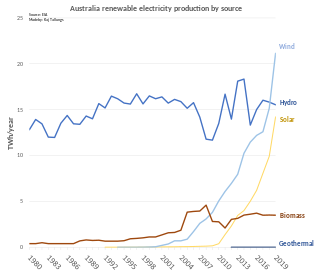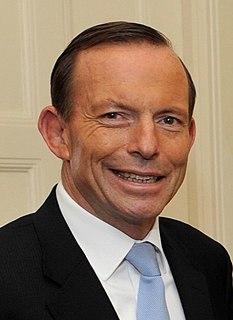
The Australian Greens, commonly known as The Greens, are a confederation of Green state/territory political parties in Australia. As of the 2019 federal election, the Greens are currently the third largest political party in Australia by vote. The leader of the party is Adam Bandt, and the party's co-deputy leaders are Larissa Waters and Nick McKim.

Kevin Michael Rudd is an Australian former politician and diplomat who served as the 26th prime minister of Australia, from December 2007 to June 2010 and again from June 2013 to September 2013. He held office as the leader of the Australian Labor Party (ALP).

Julia Eileen Gillard is an Australian former politician who served as the 27th prime minister of Australia from 2010 to 2013. She held office as leader of the Australian Labor Party (ALP). She is the first and only female prime minister in Australian history.

Anthony John Abbott is an Australian former politician. He served as the 28th prime minister of Australia from 2013 to 2015, holding office as the leader of the Liberal Party of Australia.

Antony Harold Curties Windsor, is a former Australian politician. Windsor was an independent member for the New South Wales Legislative Assembly seat of Tamworth from 1991 to 2001 − supporting the incumbent Greiner Liberal/National Coalition minority government at the 1991 election.

Renewable energy in Australia includes wind power, hydroelectricity, solar PV, heat pumps, geothermal, wave and solar thermal energy.

The Carbon Pollution Reduction Scheme was a cap-and-trade emissions trading scheme for anthropogenic greenhouse gases proposed by the Rudd government, as part of its climate change policy, which had been due to commence in Australia in 2010. It marked a major change in the energy policy of Australia. The policy began to be formulated in April 2007, when the federal Labor Party was in Opposition and the six Labor-controlled states commissioned an independent review on energy policy, the Garnaut Climate Change Review, which published a number of reports. After Labor won the 2007 federal election and formed government, it published a Green Paper on climate change for discussion and comment. The Federal Treasury then modelled some of the financial and economic impacts of the proposed CPRS scheme.

Professor Ross Garnaut led two climate change reviews, the first commencing in 2007 and the second in 2010.

Emission trading (ETS) for carbon dioxide (CO2) and other greenhouse gases (GHG) is a form of carbon pricing. It is an approach to limit climate change by creating a market with limited allowances for emissions. This can lower competitiveness of fossil fuels and accelerate investments into low carbon sources of energy such as wind power and photovoltaics. Fossil fuels are the main driver for climate change. They account for 89% of all CO2 emissions and 68% of all GHG emissions.
Greenhouse gas emissions by Australia totalled 533 million tonnes CO2-equivalent based on Greenhouse Gas national inventory report data for 2019; representing per capita CO2e emissions of 21 tons, three times the global average. Coal was responsible for 30% of emissions. National Greenhouse Gas Inventory estimates for the year to March 2021 were 494.2 million tonnes, which is 27.8 million tonnes, or 5.3%, lower than the previous year. It is 20.8% lower than in 2005. According to the government, the result reflects the decrease in transport emissions due to COVID-19 restrictions, reduced fugitive emissions, and reductions in emissions from electricity. There were however increased emissions from the land and agriculture sectors.

The Rudd Government (2007–2010) was the executive government of Australia formed by the Australian Labor Party (ALP) and led by Prime Minister Kevin Rudd. The Rudd Government commenced on 3 December 2007, when Rudd was sworn in along with his ministry. This took place just nine days after the defeat of the Howard Government, which was a Coalition of members of the Liberal and National parties, at the 2007 federal election. The Rudd Government concluded on 24 June 2010 when Rudd, under pressure from an impending leadership caucus ballot, stepped down from the leadership of the ALP and was succeeded by his deputy, Julia Gillard. Rudd was re-elected leader of the Labor Party in 2013 and served a second term as prime minister.

The New Zealand Emissions Trading Scheme is a partial-coverage all-free allocation uncapped highly internationally linked emissions trading scheme. The NZ ETS was first legislated in the Climate Change Response Amendment Act 2008 in September 2008 under the Fifth Labour Government of New Zealand and then amended in November 2009 and in November 2012 by the Fifth National Government of New Zealand.

A leadership spill for the Liberal Party of Australia was held on 1 December 2009. The incumbent leader Malcolm Turnbull was defeated by Tony Abbott on the second ballot; Joe Hockey also stood as a candidate. Abbott thus replaced Turnbull as Leader of the Opposition, and would lead the party to the 2010 federal election.

A leadership spill occurred in the Australian Labor Party on 24 June 2010. Kevin Rudd, the Prime Minister of Australia, was challenged by Julia Gillard, the Deputy Prime Minister of Australia, for the leadership of the Australian Labor Party. Gillard won the election unopposed after Rudd declined to contest, choosing instead to resign. Gillard was duly sworn in as prime minister by Quentin Bryce, the Governor-General, on 24 June 2010 at Government House, becoming Australia's first female prime minister.

The Gillard Government was the Government of Australia led by the 27th Prime Minister of Australia, Julia Gillard, of the Australian Labor Party. The Gillard Government succeeded the First Rudd Government by way of the Labor Party leadership spill, and began on 24 June 2010, with Gillard sworn in as Prime Minister by the Governor-General of Australia, Quentin Bryce. The Gillard Government ended when Kevin Rudd won back the leadership of the Australian Labor Party on 26 June 2013 and commenced the Second Rudd Government.

The 2013 Australianfederal election to elect the members of the 44th Parliament of Australia took place on 7 September 2013. The centre-right Liberal/National Coalition opposition led by Opposition leader Tony Abbott of the Liberal Party of Australia and Coalition partner the National Party of Australia, led by Warren Truss, defeated the incumbent centre-left Labor Party government of Prime Minister Kevin Rudd by an 18-seat 3.6 percentage point two-party swing resulting in a landslide win for the Coalition. Labor had been in government for six years since first being elected in the 2007 election. This election marked the end of the Rudd-Gillard-Rudd Labor government and the start of the current Abbott-Turnbull-Morrison Liberal-National Coalition government. Abbott was sworn in by the Governor-General, Quentin Bryce, as Australia's new Prime Minister on 18 September 2013, along with the Abbott Ministry and the members of the House of Representatives. The 44th Parliament of Australia opened on 12 November 2013, which is taken to be the commencement of the term of members of the House of Representatives. The new senators were sworn in by the next Governor-General Peter Cosgrove on 7 July 2014, with their six-year terms commencing on 1 July.
The Climate Change Response Amendment Act 2008 was a statute enacted in September 2008 by the Fifth Labour Government of New Zealand that established the first version of the New Zealand Emissions Trading Scheme, a national all-sectors all-greenhouse gases uncapped and highly internationally linked emissions trading scheme.
A carbon pricing scheme in Australia was introduced by the Gillard Labor minority government in 2011 as the Clean Energy Act 2011 which came into effect on 1 July 2012. Emissions from companies subject to the scheme dropped 7% upon its introduction. As a result of being in place for such a short time, and because the then Opposition leader Tony Abbott indicated he intended to repeal "the carbon tax", regulated organisations responded rather weakly, with very few investments in emissions reductions being made. The scheme was repealed on 17 July 2014, backdated to 1 July 2014. In its place the Abbott Government set up the Emission Reduction Fund in December 2014. Emissions thereafter resumed their growth evident before the tax.

The Second Rudd Government was the federal executive Government of Australia led by Prime Minister Kevin Rudd of the Australian Labor Party. It commenced on 27 June 2013 and ceased on 18 September 2013. Rudd had previously served a term as Prime Minister from 2007 to 2010 and been replaced by his deputy Julia Gillard, following an internal party spill. Rudd regained the Labor Party leadership by successfully re-challenging Gillard in a June 2013 party spill. On 5 August, Rudd called an election for 7 September 2013, which resulted in the defeat of his government by the Liberal/National Coalition led by Opposition Leader Tony Abbott.
National Energy Guarantee (NEG) was an energy policy proposed by the Turnbull government in late 2017 to deal with rising energy prices in Australia and lack of clarity for energy companies to invest in energy infrastructure. The policy specifically targets energy companies in the National Electricity Market and large energy users to have a reliability obligation as well as emissions reduction obligations.













